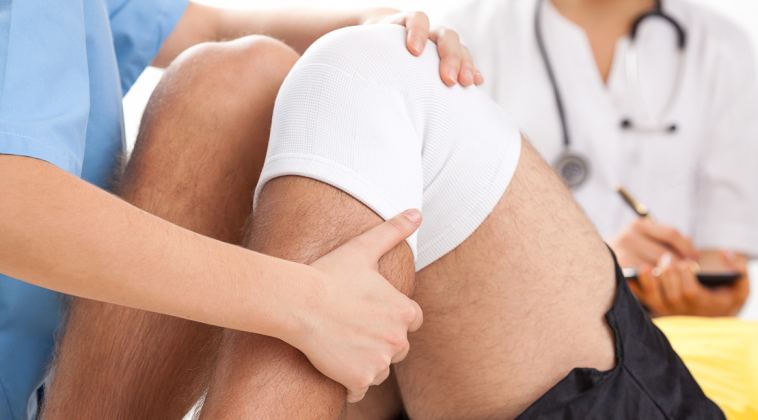- Like
- SHARE
- Digg
- Del
- Tumblr
- VKontakte
- Flattr
- Buffer
- Love This
- Save
- Odnoklassniki
- Meneame
- Blogger
- Amazon
- Yahoo Mail
- Gmail
- AOL
- Newsvine
- HackerNews
- Evernote
- MySpace
- Mail.ru
- Viadeo
- Line
- Comments
- Yummly
- SMS
- Viber
- Telegram
- JOIN
- Skype
- Facebook Messenger
- Kakao
- LiveJournal
- Yammer
- Edgar
- Fintel
- Mix
- Instapaper
- Copy Link
Progressive strength training as good as it is for you, can be tough on your joints. There will be times when your squats, deadlift, or lunges, and your knees will flip you the bird. You ignore this at first until it happens again. Then again and again. Well, you get the picture. Working around or through knee pain is no fun. In short, it sucks.
When you’re training with knee pain, there is nothing to escape it, except to ignore it or fight through it.
You try all kinds of things like reducing the weight, changing your foot position, or changing the exercise variation in the hope your knee will behave itself. If you tried this and your knees are still bothering you, then these 6 coaches have got your back.
Here are six recommended exercises that will help strengthen your knee joints to reduce knee pain so you can keep crushing your training.
Note: If you’ve had persistent knee pain for a while now, please seek medical advice. This advice is for undiagnosed knee pain and is not a substitute for professional medical advice.
Skater Hop and Stick
Recommended By: Mike T. Nelson Ph.D, a metabolism fitness professional, strength coach, and educator who specializes in tailoring nutrition to each individual.
Why it is good: Most people don’t get enough side-to-side (frontal plane) movement. This exercise is typically used to improve lateral power and deceleration but is a great exercise for your knees because it strengthens the quads, hamstring, and glutes. Plus, it is easily progressed and regressed.
How to do it: You can do this barefoot or with shoes. As you get more aggressive, you can bend more and stay in an athletic stance Start super easy and progress over time When you can, keep pressure on your big toe will help.
Programming suggestions: Nelson suggests adding this as part of a warmup for eight to 10 reps per side or for move volume as a dedicated exercise one to two times a week.
Knee Gapping
Recommended by: Dr. Bo Babenko, physical therapist and strength coach who specializes in strengthening the mind, body, and soul.
Why it is good: With knee gapping It’s important to understand that the knee joint is very simple and oversimplified can only bend forward and back ( flexion-extension). Any imbalances or stresses from the foot or hip that pull it off of its “straight path“ are likely doing small bits of damage with every rep. One of the best tools to keep the knee joints healthier for much longer is to create this gapping effect that ultimately decompresses the knee joint and allows those built-up daily damages to be cleared.
How to do it: While sitting down, get any medium-size hardball. Placing it behind the knee, grab the knee below the kneecap and press, while moving the foot around.
Programming suggestion: This drill should be performed multiple times per week. Assuming no active pain, the prescription becomes accumulating at least 10 total minutes per week. Again, this will always depend on injury status, general tissue health, and training age.
Negative Step Up
Recommended by: Raphael Konforti MS, senior director of fitness at You Fit Gyms.
Why it is good: If a client is experiencing knee soreness, don’t just train around it, Konforti says. “I want to train so that their knee gets more durable and they’re less likely to come back with the same issue down the road. Including unilateral, or single leg work, is critical to avoiding injuries, coming back from them, and continuing to train through soreness.” The negative step up places less strain on the knee than other lunge-style exercises by optimizing biomechanics angles and spreading weight out to the hip joint. The extended negative part of the rep uses temp to add the burn and challenge needed to make gains you usually get by using more weight.
How to do it: Place one foot onto a box so your shin is vertical, and your knee is at 90 degrees. Without using momentum, step up, pushing through the heel and ball of the foot. For an added challenge pause at the top, lifting the opposite knee to hip height through the pause. Slowly lower back to the starting position — for about a three count — keeping the hips even and shin perpendicular. Throughout the movement, stay focused on keeping an arch in the foot, maintaining consistent contact throughout the foot, and keeping the knee in line with the foot so the knee doesn’t collapse inward or lean outward.
Programming suggestion: Include this move up to two times per week. Perform 12 to 15 reps on each side for three sets, resting 60 seconds between each leg. Since it uses a lot of stabilizer muscles, put this as the second or third lower body exercise after a hip-dominant exercise like deadlifts.
Sissy Squat
Recommended by: Allan Bacon, Ph.D. is a former dental surgeon now an online personal trainer who specializes in training powerlifters and body composition clients.
Why it is good: Bacon recommends the sissy squat for those experiencing knee pain because it is both knee sparing and comfortable when set up correctly. “It allows you to work on both strength and stability around the knee joints and gives you a wicked quad pump,” he says.
How to do it: Set the bar roughly mid to upper-calf height and use a squat or hip-thrust pad for comfort. You want to be able to bend fully at the knee, but also want support high enough to allow you to sit down into the squat. Maintain a relatively upright torso, although a slight forward bend is perfectly acceptable.
Brace your toes with a box, dumbbells, or a sandbag. This doesn’t need to be heavy or pinning your toes down, only something to keep your feet from sliding forward as you descend and keep your weight centered towards your heels for stability.
Start your sissy squat progression by using a reduced range of motion. Work up until the point before any aggravation to the knee or just prior to form degradation. Progress range of motion over time until you are covering the entire range of tension on your quads. Once you can complete a full range of motion, increase the difficulty by holding a plate against your chest or a dumbbell in a goblet setup.
Programming suggestions: Bacon recommends starting with three sets of 10 (adjusting for ability) and working your way up to four sets of 15 focusing on controlling the eccentric (lowering) portion of the movement.
Eccentric Active Thomas Test
Recommended by: Travis Pollen, Ph.D., an exercise science professor, personal trainer, co-creator of the Strength For Yoga program, and cofounder of 3M Athletic Performance gym
Why it is good: It’s worth paying extra attention to hip mobility. Given the proximity of the hip to the knee, freeing up some extra hip mobility can do the knee solid. The Thomas Test is a position physical therapists use to assess the hip flexors – and specifically, the rectus femoris, which is both a hip flexor and a quad muscle (hence the importance for the knee). “In the gym, we can turn the Thomas test into a mobility exercise by performing it actively, with an emphasis on the eccentric phase,” Pollen says.
How to do it: Lie on your back on a workout bench. Pull your right knee in toward your chest and hold it in place. Draw your left knee in, then straighten the left leg towards the ceiling. Slowly lower that straight left leg towards the bench. Once you feel a good stretch on the front of your left hip, bend the left knee to shift the emphasis of the stretch to the quad. Return to the start position and repeat for the desired number of reps on both sides.
Programming suggestion: This mobility drill can be used in the warmup, cooldown, or in between sets of a big lift (e.g., squat, bench, deadlift) for two to three sets of six to eight reps per side.
Straight-Leg Hip Lift
Recommended By: Andrew Heming, MS, CSCS, a college strength and conditioning coach
Why it is good: According to Heming, “This exercise works your glutes, hamstrings, and calves while avoiding direct loading or bending of the knee. I have even used this post-knee surgery when I was not able to bend my knee.”
How to do it: Lie on the floor and place the ball of one foot up on an incline bench or other sturdy object Keep a slight bend in your knee so muscles and not your ligaments support your knee. If you feel stress in the back of your knee, try bending your knee a little more. Pull the knee of your other leg up towards your chest. Contract your glutes and drive the ball of your foot into the bench. Come up until your body is in a straight line and pause for a few counts at the top. You can increase the range of motion by placing your shoulders upon another sturdy bench.
Programming suggestions: This exercise is not suited to very low rep training. Because there is no spinal loading and low overall body stress, you can use this more frequently and with higher volume than a big lift like a deadlift. Try performing this exercise up to three times per week for two to four sets of six to 15 repetitions.


